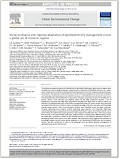| Journal Article |
 |
|
| Article Title | Social-ecological and regional adaptation of agrobiodiversity management across a global set of research regions | | Author | L.E. Jackson, M.M. Pulleman, L Brussaard, K.S. Bawa, G.G. Brown, I.M. Cardoso, P C De Ruiter, L. Garci´a-Barrios, A.D. Hollander, P. Lavelle, E. Oue´draogo, U. Pascual, S. Setty, S.M. Smukler, T. Tscharntke and Meine van Noordwijk | | Year | 2012 | | Journal Title | Global Environmental Change | | Institution | Elsevier Ltd | | Pages | 1-17 | | Call Number | JA0450-12 | | Keywords | Biodiversity, Agricultural intensification, Agricultural landscapes, Ecological intensification, Multiple ecosystem services, Social-ecological domain |
|
| Abstract: |
| To examine management options for biodiversity in agricultural landscapes, eight research regions were
classified into social-ecological domains, using a dataset of indicators of livelihood resources, i.e., capital
assets. Potential interventions for biodiversity-based agriculture were then compared among landscapes
and domains. The approach combined literature review with expert judgment by researchers working in
each landscape. Each landscape was described for land use, rural livelihoods and attitudes of social actors
toward biodiversity and intensification of agriculture. Principal components analysis of 40 indicators of
natural, human, social, financial and physical capital for the eight landscapes showed a loss of
biodiversity associated with high-input agricultural intensification. High levels of natural capital (e.g.
indicators of wildland biodiversity conservation and agrobiodiversity for human needs) were positively
associated with indicators of human capital, including knowledge of the flora and fauna and knowledge
sharing among farmers. Three social-ecological domains were identified across the eight landscapes
(Tropical Agriculture-Forest Matrix, Tropical Degrading Agroecosystem, and Temperate High-Input
Commodity Agriculture) using hierarchical clustering of the indicator values. Each domain shared a set of
interventions for biodiversity-based agriculture and ecological intensification that could also increase
food security in the impoverished landscapes. Implementation of interventions differed greatly among
the landscapes, e.g. financial capital for new farming practices in the Intensive Agriculture domain vs.
developing market value chains in the other domains. This exploratory study suggests that indicators of
knowledge systems should receive greater emphasis in the monitoring of biodiversity and ecosystem
services, and that inventories of assets at the landscape level can inform adaptive management of
agrobiodiversity-based interventions. |
|